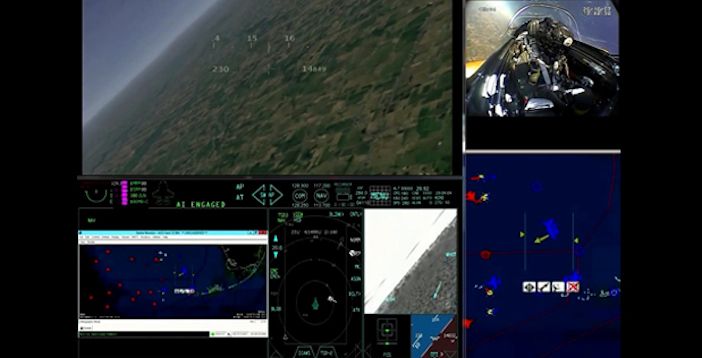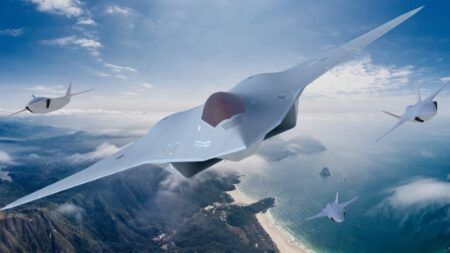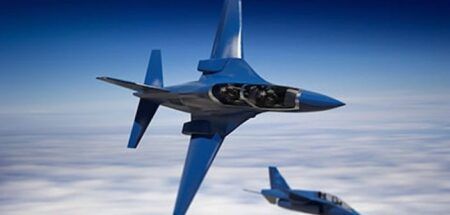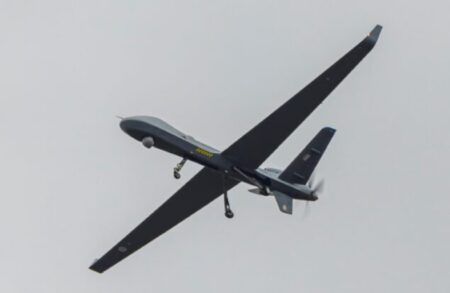Researchers in the USA are on course to flight test the first AI-fighter pilot technology during 2023 after running the first successful virtual simulations using algorithms.
The artificial intelligence (AI) will be capable of controlling aircraft during dogfights and in teaming applications and has already passed several key milestones during its first phase of development in simulated dogfights.
Researchers on DARPA’s (Defense Advanced Research Projects Agency ) ACE (Air Combat Evolution) program, which started last year, will conduct the first sub-scale test flights at the end of this year.
The aim of the ACE program is to develop trusted, scalable, human-level, AI-driven autonomy for air combat by using human-machine collaborative dogfighting as its challenge problem.
The phase 1 milestones so far achieved include the running of virtual AI-controlled dogfights involving several aircraft. Engineers have also run flight tests to measure pilot physiology and trust in AI and have started making the initial modifications to the full-scale aircraft – an L-39 trainer jet that will be flown by the first onboard AI-fighter pilot by the end of 2023.
Col. Dan “Animal” Javorsek, program manager in DARPA’s Strategic Technology Office said, “Our biggest focus at the end of phase 1 is on the simulation-to-real transition of the AI algorithms as we prepare for live-fly sub-scale aircraft scenarios in late 2021.
“Managing this transition to the real world is a critical test for most AI algorithms. In fact, prior efforts have been brittle to just these types of transitions because some solutions can be over reliant on digital artifacts from the simulation environment.”
The sub-scale aircraft testing scheduled for the end of this year represents phase 2 of the ACE program. Meanwhile, aerospace research and testing company Calspan has already begun to modify the L-39 that will be piloted by the AI in live-fly team dogfights during Phase 3 of the program, expected to take place in late 2023 and early 2024.
The work to deploy the AI on the L-39 includes first creating an aero-performance model of the aircraft so the AI can make predictions and tactical maneuvering decisions during combat. Once the model is complete, the L-39 will be fully modified so that the AI can take control of the aircraft.
Dogfight trials
The virtual AlphaDogfight trials were conducted by the Johns Hopkins Applied Physics Laboratory (APL) during August 2020 and involved eight APL-teams whose AIs flew simulated F-16s in 1-v-1 aerial dogfights.
The champion AI then flew five simulated dogfights against an experienced F-16 fighter pilot in a simulator. The AI beat the human 5-0.
Last month, the ACE algorithm-development teams demonstrated 2-v-1 simulated engagements with two friendly “blue” F-16s fighting as a team against an enemy “red” aircraft. This simulation introduced more weapons – a gun for precise, shorter-range shots, and a missile for longer-range targets.

“Adding more weapon options and multiple aircraft introduces a lot of the dynamics that we were unable to push and explore in the AlphaDogfight Trials,” Javorsek said. “These new engagements represent an important step in building trust in the algorithms since they allow us to assess how the AI agents handle clear avenue of fire restrictions set up to prevent fratricide.
“This is exceedingly important when operating with offensive weapons in a dynamic and confusing environment that includes a manned fighter and also affords the opportunity to increase the complexity and teaming associated with maneuvering two aircraft in relation to an adversary.”
Pilot trust flight testing
Another major focus of the ACE program is measuring pilot trust in the AI’s ability to conduct combat maneuvers while the human on board focuses on higher-cognitive battle management decisions. To begin capturing this trust data, test pilots have flown several flights in an L-29 jet trainer at the University of Iowa Technology Institute’s Operator Performance Laboratory.
The two-seat jet is outfitted with sensors in the cockpit to measure pilot physiological responses, giving researchers clues as to whether the pilot is trusting the AI or not. The jet is flown by a safety pilot in the front cockpit who executes flight control inputs generated by an AI so it appears as if the AI is performing the aircraft maneuvers to an evaluator in the back seat of the aircraft.
Javorsek said, “In an analog to the miles per disengagement used in self-driving cars, we are recording the time per disengagement, which serves as a major metric for the program.
“In addition, we’ve started looking at measurement techniques to see where the evaluation pilot’s head is pointing, as well as where their eyes are looking around the cockpit. This enables us to see how much the pilot is checking on the autonomy by looking outside the window and comparing that to how much time they spend on their battle management task.”
The ACE program is also researching two independent frameworks for an AI Battle Manager, in what has been deemed the AlphaMosaic agent and campaign scale command and control. Contractor teams are refining their agents and architectures in preparation for head-to-head competition at the end of the first phase of the program.




